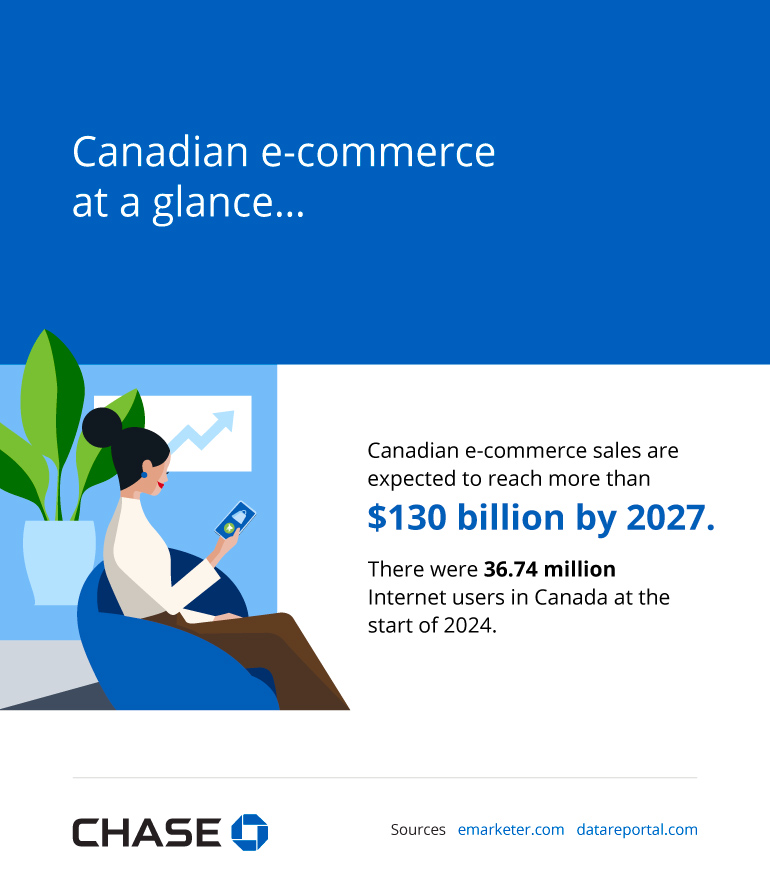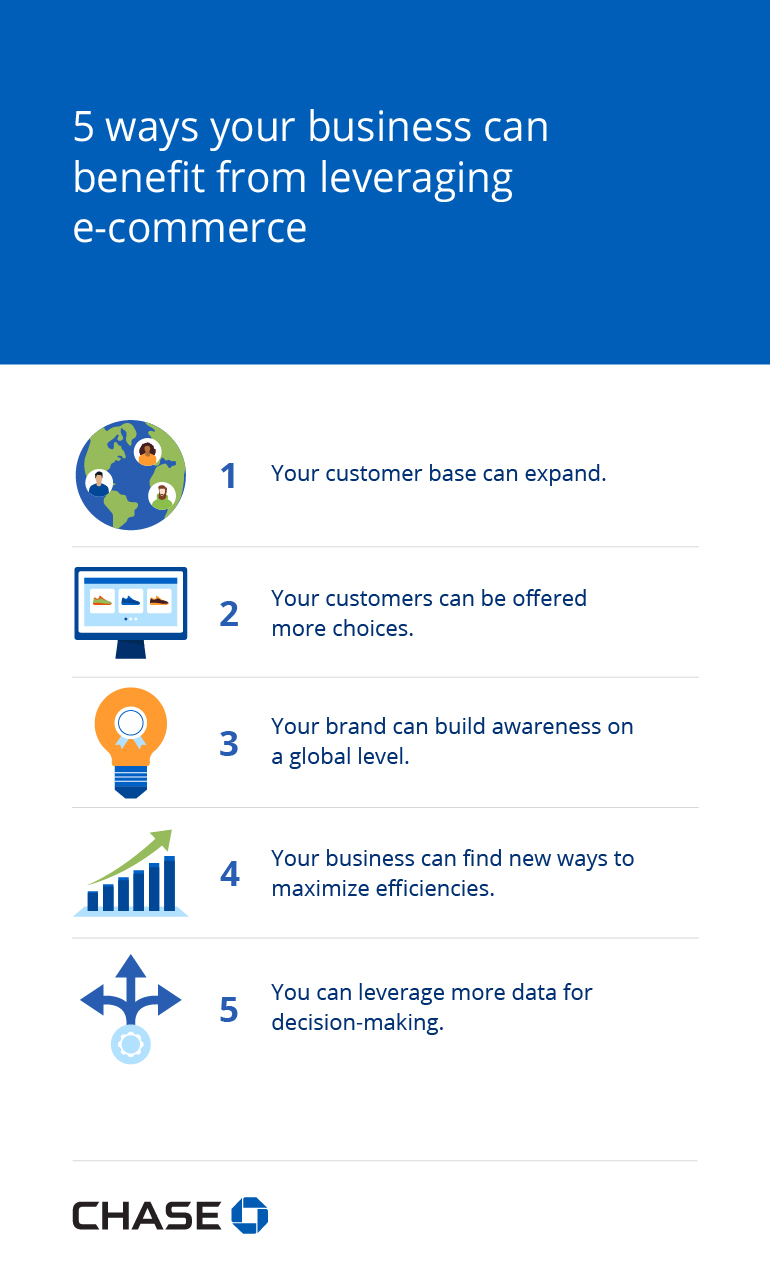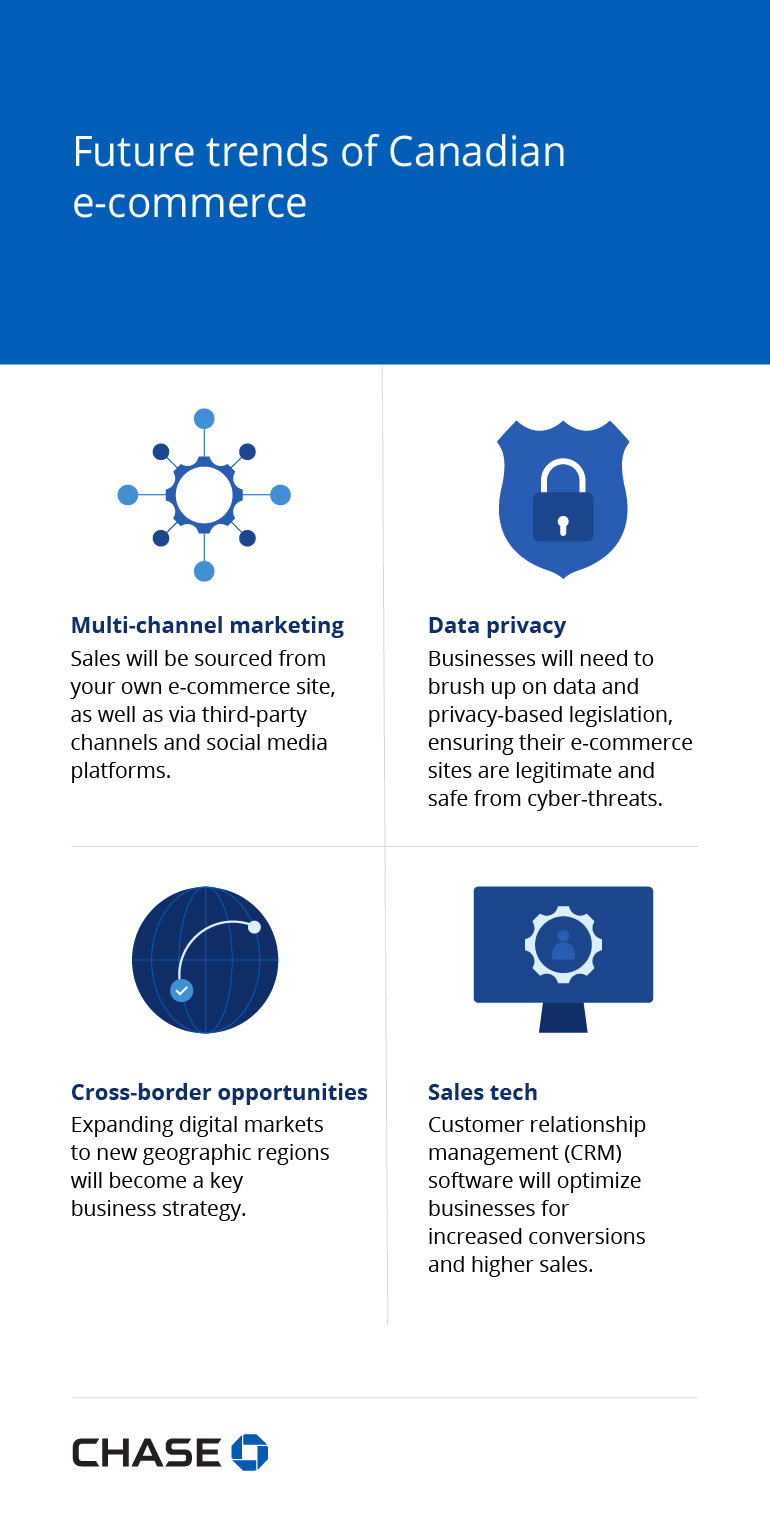The past, present and future of Canadian e-commerce
By Amanda Reaume

With Canadian e-commerce sales expected to reach more than $130 billion by 2027, online sales have come a long way since the earliest days of the Internet, almost half a century ago.
With Canadian e-commerce thriving, it’s a perfect time to revisit the past, explore the present and look toward the future of online sales to help Canadian businesses build on their success, understand the current landscape and maximize their future online revenue.
Canada’s e-commerce history
The history of Canadian e-commerce is the story of a slow rollout. Canadian retailers notably lagged behind their global peers in setting up e-commerce sites in the early 2000s and 2010s, when the move to digital began in earnest. However, there has been a steady increase in the adoption of digital channels by Canadian consumers and retailers, and now nearly 12% of Canada's retail sales are e-commerce. As a country with one of the highest global levels of Internet usage (there were 36.74 million Internet users in Canada at the start of 2024), it’s not surprising that e-commerce has come to resonate so well with Canadian consumers.
Additionally, due to market changes and demand, companies have doubled down on their e-commerce efforts. Many have transitioned to online ordering, delivery, and curbside pickup, increasing Canadians' e-commerce options and accessibility.

- Canadian e-commerce sales are expected to reach more than $130 billion by 2027.
- There were 36.74 million Internet users in Canada at the start of 2024.
Sources:
Benefits of the e-commerce present
E-commerce is considered by many to be retail's great equalizer because it allows companies of all sizes to reach a global, theoretically endless, customer base. But, given the relatively recent shift to online ordering by Canadian consumers, it also ensures that established businesses can keep their current customer base.
Canadian businesses that aren’t entering or expanding their online offerings are likely to watch their more digital-savvy peers erode their market share. Here are some key benefits of an effective e-commerce strategy:
Expanding your customer base
One of e-commerce’s greatest benefits is its efficiency. It doesn’t require a physical footprint, so it saves capital, while simultaneously giving small- and medium-sized businesses access to a much larger digital market. With just a Uniform Resource Locator (URL) you can reach all of Canada, the U.S., or perhaps an entirely global customer base.
Giving your customers more choices
Digital sales tend to offer customers a more convenient user experience (shopping from the comfort of home or on the go), as well as an expanded inventory.
Via e-commerce, companies can offer more products or product options than they might have room to store in a physical location. In addition, many companies create a digital strategy that involves selling on different channels such as Amazon, their own website and the e-commerce sites of partners or buyers, giving customers even more control over how and what they buy.
Building global brand awareness
For businesses, physically expanding into new markets isn’t just expensive, it can be risky. There are significant expenses to marketing and opening physical stores in new markets — investments that might not pay off if that market hasn’t been tested for demand. Online stores can mitigate that risk while still building brand awareness and closing sales. They can also capture customer interest and excitement with features like pre-ordering, as well as e-mail subscription models that keep prospective buyers updated about product launches.
Maximizing business efficiencies
E-commerce enables businesses to streamline budgets that were previously consumed by rent, payroll, or other expenses. The overhead costs of online sales are relatively low compared to selling in a physical store, allowing businesses to maintain a certain level of fiscal flexibility.
Leveraging data
For consumer product companies that have historically sold wholesale, e-commerce is an opportunity to sell directly to buyers for the first time. This doesn’t just help improve profit margins, it also gives businesses access to consumer data that they previously didn’t have — leveraging that data (like customer demographics or customer preferences) can help businesses improve processes, launch new products, or craft better marketing plans.

- Your customer base can expand.
- Your consumers can be offered more choices.
- Your brand can build awareness on a global level.
- Your business can find new ways to maximize efficiencies.
- You can leverage more data for decision-making.
Barriers to e-commerce success
So, if e-commerce is such a no-brainer, why aren’t all Canadian businesses on the online sales bandwagon? Unfortunately, online stores can be complicated and take a considerable amount of time to set up. They also require initial and ongoing investments in web development, online sales infrastructure, product inventory software, delivery logistics and website updates. Many established small- and medium-sized businesses become overwhelmed just thinking about the transition to e-commerce. Here are some challenges they often come across in this process:
Reporting e-commerce income on taxes
This one is fairly easy to overcome, but it is an important barrier to keep in mind. In Canada, companies that earn income from one or more webpages or websites need to report their web addresses and the income they earn. Companies with different business structures have different reporting requirements. Figuring out how to navigate this, however, just requires a good accountant.
Learning how to make cross-border sales
One of the benefits of online sales is accessing an international customer base. However, that’s also one of the barriers. The rules and processes involved can often make navigating cross-border complexities overwhelming. It can also be expensive for Canadian businesses to ship to and from the U.S. and other countries due to customs duties and shipping limitations. Working with an e-commerce expert or consultant can help companies weigh the benefits and drawbacks of different markets and come up with a strategy to target the desired markets.
The potential for fraud and cybersecurity attacks
Sadly, operating an online store opens your business up to all kinds of cyber liabilities and theft. Criminals are known to target e-commerce sites by using stolen or fraudulent credit cards. When the false charges are reported by the true cardholders, the stolen sales are refunded, leading to additional revenue losses on your end. In addition, cybercriminals are more likely to hack your customer data, leading to potential reputational damage and harm to your customers. If your company is going digital, you should invest in both cyber liability insurance and an effective cyber security strategy to protect yourself and your customers.
The future of Canadian e-commerce
Despite the expected hurdles, the future of Canadian e-commerce is both profitable and bright. Which begs the question: What exactly will it look like? There are all sorts of ways technology will continue to make e-commerce more effective and boost the revenue of Canadian businesses. Here are some of e-commerce’s predicted trends:
Multi-channel marketing
Multi-channel or omni-channel marketing and sales are probably the biggest future trend for e-commerce. Companies will be marketing to customers through their own avenues, including different social media sites, email and mobile. But they will also be selling through multiple independent channels. For example, a company might have their own website but also sell on Amazon, Instagram and other companies’ retail sites as a third-party operator.
Data privacy
As previously noted, the opportunities of e-commerce don’t come without challenges, and the biggest challenge for Canadian e-commerce companies is going to be data privacy. Governments are doing their best to legislate data privacy and make consumer-protected compliance a necessary focus of e-commerce companies. The challenge is that companies that are selling globally will have to grapple with different privacy requirements for each international market. For example, companies that sell to European Union residents will need to ensure they’re compliant with the General Data Protection Regulation (GDPR), which requires data about EU residents to be stored in the EU or in a jurisdiction with similar privacy laws. The technical and infrastructure challenge of that can be considerable for small- to medium-sized businesses with tight budgets.
Cross-border opportunities
As companies grow their online business, expanding their digital markets to new geographic regions will become a key business strategy. The good news is that this demand will produce more support businesses, database infrastructures and consultancies on the horizon to help streamline the process of entering new markets — from complying with the regulatory requirements to shipping products there, to ensuring a company’s website loads fast enough for its global users.
Sales tech
Customer relationship management (CRM) software has seen a revolution in recent years and those innovations are finally starting to become available to small- and medium-sized businesses at reasonable rates. Exciting innovations include the ability of e-commerce sites to use customer data (as well as AI) to alter search results, prioritizing things that the customer is more likely to buy based on past purchases. It also includes automated systems that message customers who abandon items in their virtual shopping cart, reminding them to come back to purchase them. Essentially, e-commerce is in the process of being optimized for increased conversions and higher sales. It is also becoming increasingly easy and accessible for small businesses. That’s exciting (and profitable) news!

Multi-channel marketing:
Sales will be sourced from your own e-commerce site, as well as via third-party channels and social media platforms.
Data privacy:
Businesses will need to brush up on data and privacy-based legislation, ensuring their e-commerce sites are legitimate and safe from cyber-threats.
Cross-border opportunities:
Expanding digital markets to new geographic regions will become a key business strategy.
Sales tech:
Customer relationship management (CRM) software will optimize businesses for increased conversions and higher sales.
Is your business prepared for the e-commerce revolution?
If your business isn’t online, now is a great time to create a digital sales strategy and ensure you’re not left behind. If you are operating an e-commerce site, consider streamlining your digital operations, moving into new markets, payment solutions and finding alternative ways to grow your online sales. Companies that don’t take action on their e-commerce strategy could miss out on the chance to boost their sales and grow their companies. If you feel uncertain about how to navigate digital commerce’s complexities, reaching out to an e-commerce expert may be the key to finding success.